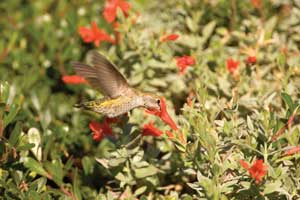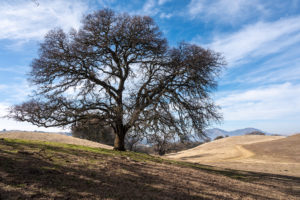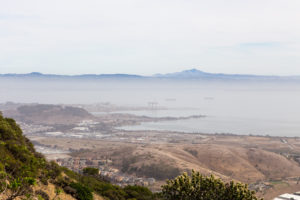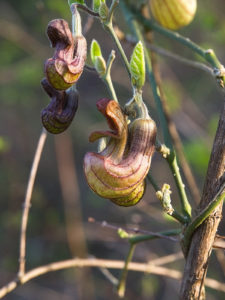From a speeding car, the Regional Parks Botanic Garden in Tilden Park is a quick blur of green surrounded by a chain-link fence with a single sign bearing its cumbersome, dryly bureaucratic name. But there is concentrated, elemental magic in this place that can’t be sensed from a drive-by or a Google Earth flyover, a photo or a written description. Its ten acres, nestled in the canyon of Wildcat Creek, hold much of the plant diversity of California’s wild landscapes and can charm even the first-time visitor with a wonderful and mysterious spell.
Perhaps this magic lies in the energy of the place—the life force of the plants coupled with what a longtime employee describes as all the love put into the garden by those who have designed and nurtured it. Perhaps it’s the stories the garden holds: earth stories of wild places, adaptation, evolution, and extinction, and human stories of struggle, failure, and triumph. Perhaps it’s the grand yet intimate beauty of the place. Most likely it’s all of these things and many more we’ll never understand.
Some of the Botanic Garden’s unique magic stems from its primary purpose: to create the most beautiful and diverse landscape possible using only California native plants. There are just two other public botanic gardens in the world devoted exclusively to California native plants, both in Southern California. Although the garden in Tilden is by far the smallest, its northern-central latitude and specific location on the east flank of the Berkeley hills provide habitat for plants from a wider range of environments around the state than either of the two Southern California gardens. Nearly every corner of the state is represented here, from the deserts and arid mountains of southeastern California to the rainy northern coastal forests, and from the alpine Sierra Nevada to our own Bay Area backyard.
As natural as the garden looks, it is a created landscape. Only clever manipulation of the local environment permits so many of California’s wild plants to be represented here. Yet nature’s magic is always at work, giving this man-made habitat an ever-changing life of its own.
Winter reveals the garden’s quietest secrets: stark forms and intricate architecture of trees; bright lichens and mosses clothing rocks, branches, railings, and walls; ladybugs hibernating in the protection of bunchgrass clumps; and the flowers of manzanita, pipevine, silk-tassel, and slink-pod, which are all specially adapted to this season of fewer pollinators.
Nature also reveals her winter work in more powerful ways: Huge trees sway and bend in stormy winds and rainwater pours into the garden from dozens of channels, culverts, and unintended places, at times turning the creek into a thundering torrent that rises two feet over the course of an hour.
The brilliant new-life green of spring foliage follows the quiet and passion of winter, and the garden displays its most spectacular colors. Dazzling combinations of flowers paint the landscape, like the canopy of deep magenta western redbud flowers over a sky-blue carpet of fragrant creeping sage. Golden-orange California poppies knit the garden together with their vagabond ways, colonizing and brightening every sunny bed, crack, and crevice.
In summer, the chartreuse leaves of spring mature into deep green canopies of shade and cool refuge. The creek trickles and slides gently down the center of its channel, now lined with greenery that in places almost hides the water from view. In the fall, reds, oranges, yellows, and browns warm the green landscape as leaves turn and late-season flowers like bright crimson California fuchsias and golden gumplants bloom.
But there’s more than beauty here. Every plant in the garden has stories—of the wild place it came from, of its ancestors’ adaptation to that place, and of how the earth’s history shaped its past.
The plants have human stories, as well—of amusing foibles in pursuit of specimens, of dramatic scientific discoveries, of persistent trial and error in cultivation, and of habitat loss and conservation. In his 1959 guide to the garden, founding director James Roof recounts the story of the Franciscan manzanita (Arctostaphylos hookeri ssp. franciscana), a rare form native to just one site in the Laurel Heights district of San Francisco. This plant was discovered there in 1905 by Alice Eastwood, the famous curator of botany at the California Academy of Sciences, but it was bulldozed into extinction in the early 1940s, save for plants rescued by Roof and planted in the Botanic Garden. Roof writes:
When she was over ninety years old Miss Alice Eastwood walked to this spot in the Botanic Garden, sat on a stone, and wept a little to see this species, which she discovered and named. “Tumbling over the stones,” she said, “it looks exactly as it used to at Laurel Hill.” This is San Francisco’s own manzanita, which San Francisco has subdivided out of existence . . . These plants are “originals” from Laurel Hill, uprooted by bulldozers on the day of destruction.
Sadly, the Franciscan manzanita now exists only in cultivation, because all its native habitat has been eliminated.
Sometimes the stories are happier. Among the majestic conifers in the garden are two groves of Santa Lucia firs, the rarest firs in the world. In their limited native mountain habitat east of Big Sur, seeds of these trees are parasitized by the larvae of chalcids, small wasps that have evolved with the trees over thousands of years. Adult wasps lay their eggs inside the developing cones and when the larvae hatch, they eat the seeds from the inside out. Few viable seeds remain in years when wasp population levels are high.
However, the wasps do not live in the Bay Area and the trees in the Botanic Garden produce large amounts of viable seed. When the Marble Cone fire of 1977 burned 175,000 acres in the Santa Lucia Mountains and killed many of the firs in their wild home, foresters were able to collect quantities of good seed from trees in the Botanic Garden, which had been grown from seed originally collected in the Santa Lucias by the garden staff.
The garden has thus served as a genetic repository for these two plants. They are among the 300 kinds of rare and endangered plants grown here that cling to life in the wild. Though it is no substitute for preserving their wild habitat, their presence in the garden provides some small insurance against total extinction.
- Garden founder James Roof, on right, tends bristlecone pineseedlings in 1949. Photo courtesy East Bay Regional Park District.
Other plants simply can’t be grown in the garden. In spite of well-informed and sometimes heroic efforts by the garden staff, these plants defy all attempts at cultivation. Foxtail pine from the mountains and ocotillo from the desert cannot be induced to tolerate our climate. And yet others, like chinquapin, which grows naturally in the Oakland hills and other Bay Area locales, challenge the staff to divine the secrets of their favored growing environments and then duplicate those conditions in the garden.
James Roof wrote about hundreds of unsuccessful attempts to grow chinquapin in the garden or elsewhere. “I doubt that anyone, professional or amateur, has ever successfully grown the wicked things,” he noted. “It is the most notable failure in native plant horticulture.” He never stopped trying to grow chinquapin, but never succeeded in keeping one alive for more than a few years; most died within months after he planted them in the garden. With tongue only partly in cheek, he reported, “A friend recommended that we go to the Oakland hills, buy a lot with chinquapins on it and label it the Botanic Garden’s South Annex.”
Since Roof’s time, many other garden staff members have collected chinquapin seeds or cuttings in the wild and grown them in the garden’s greenhouse for a few years. Most of these attempts also failed once the plants were set in the ground. However, two chinquapins have now survived in the garden for more than ten years and stand as living testaments to the skill, talent, and persistence of the garden staff.
Growing chinquapins and rare plants reflects another of the garden’s primary missions: to protect and conserve the California flora in the wild. That effort requires an informed public, says Steve Edwards, the garden’s current director. “The Regional Parks Botanic Garden fills the irreplaceable role of enhancing the public’s knowledge and appreciation of the native flora of California,” he explains. “The result is a public more sensitive to the natural world that is rapidly vanishing around them.”
Public education programs at the garden have expanded under each of the garden’s three directors over its 66 years of existence. When James Roof created the garden in 1940, he welcomed all visitors, from academic researchers to curious neighbors. He also wrote extensively about native plants and started the garden’s scholarly journal, The Four Seasons.
Wayne Roderick, who served as the garden’s second director from 1976 through 1983, instituted a lecture series to teach the public about native plants; the series continues on winter Saturday mornings to this day. A renowned expert on native plants that grow from bulbs, Roderick introduced these little-known beauties to the public and planted them throughout the garden.
Steve Edwards, director since 1983, has brought a new academic focus to the garden, incorporating research in geology and anthropology, as well as botany and horticulture, into the garden’s activities. Edwards also has extended educational opportunities to an even broader audience through a volunteer docent program developed by botanist Glenn Keator. Docents lead tours of the garden for the general public on Saturday and Sunday afternoons as well as for preschool through college classes and a wide range of groups including garden clubs, Alzheimer’s support groups, Girl Scouts, and environmental volunteers.
“It is the perfect multisensory experience for young children,” says Pamela Meredith, a kindergarten teacher at Walden School in Berkeley who has been bringing her classes to the garden twice a year since 1998. “They’re able to see life cycles, which is why I bring them in the fall and then again in the spring. Docents point out things that change, so in their young vocabularies [the children] now have words like ‘deciduous.’ And they use those words. One of my students told me, ‘My teeth are deciduous.'”
The garden’s floristic abundance and diversity not only serve its human public, but also provide a spectacular smorgasbord of food and habitats for a concentration of diverse local and migrant wildlife. Its myriad animal residents and visitors include great blue herons, rainbow trout, weasels, king snakes, and a seemingly unlimited array of nectar-feeders and pollinators ranging from hummingbirds to native bees to butterflies.
Of course, not all wildlife is welcome in the garden. Tall fences keep out browsing deer that would devour the collection, given the opportunity. One such opportunity came on an otherwise quiet spring afternoon in 1981 when a tanker truck careened out of control and crashed through the garden’s fence. The driver walked away uninjured, but an ever-vigilant Tilden Park deer found the hole in the fence that night and decimated some of the garden’s most prized plants.
Along with its intricate web of life, the garden itself has a complex history. At various times, it was larger and smaller than its present ten acres; it was nearly orphaned in the mid-1960s when the East Bay Regional Park District proposed the creation of a new botanic garden in Chabot Regional Park; it has suffered the vagaries of public agency funding; and it has employed some unique human characters.
It’s hardly possible to think or talk or write about the garden without discussing its brilliant and controversial founder. James Roof’s ideas and talents were reflected in the garden’s original design and clearly persist in its present form. Before he started the garden in 1940, Roof managed a U.S. Forest Service native plant nursery that eventually formed the core of the new Botanic Garden. With help from large Works Progress Administration crews, Roof built much of the garden in two years.
Unfortunately, the garden’s auspicious beginning was largely undone when Roof was drafted and sent overseas for four years during World War II. In his absence, the garden went untended, and when he returned in 1946, he found a tangle of poison oak, waist-high grasses, and weedy forests of willow and bay trees. Starting over with only a few helpers, he cleared the brush with fire and chain saws and returned to the field over a period of years to collect the majority of the garden’s plants a second time.
Roof was both Jekyll and Hyde: Arguably the most brilliant California native plant horticulturist who ever lived and gardened and a prodigiously talented writer, he was also an independent thinker and operator who had no patience for bureaucracy or democracy. He could please his staff with impromptu field trips and hoes-down afternoons of storytelling, and then turn around and berate them cruelly for erroneously perceived incompetence. His famous intolerance for authority caused him to be reprimanded, disciplined, fired, reinstated, retired, and rehired more than once during his stormy 36 years as director.
Roof’s clashes with district administrators ultimately led to the creation of the California Native Plant Society (CNPS). In 1964, Roof was fired for insubordination and the district began planning a new 400-acre California native botanic garden in Chabot Regional Park. Roof’s admirers successfully lobbied the district’s board to abandon those plans, embrace the existing garden, and reinstate him. The committee formed in that effort expanded its mission from protection of the Botanic Garden to protection of native plants throughout the state, incorporating as CNPS. That organization now has over 9,000 members in 33 chapters around the state dedicated to the conservation of California’s flora.
For the most part, Roof operated the garden in isolation—splendid isolation, he might have said—with just a very small paid staff. But his successors, directors Roderick and Edwards, placed a new emphasis on volunteerism.
Roderick first invited volunteers to help maintain the garden, but their role expanded in 1979, when Proposition 13 budget cuts caused the Park District to institute an admission fee for the garden. The volunteers proposed an annual native plant sale in place of the fee, and that sale, now in its 29th year, still contributes significant revenue to the garden. In 1996, another group of volunteers created a Friends organization that raises additional funds for the garden and offers classes on native plants, garden art, and many other subjects.

- The garden’s rich habitat attracts pollinators like this Anna’s hummingbird, at a California fuchsia. Photo by Eleanor Briccetti.
Collectively, the garden’s volunteers contributed nearly 9,000 hours of work in 2005. All of those volunteer hours, as well as the thousands of hours visitors spend enjoying the garden, are inspired by its representation of the beauty and diversity of California’s native plant life.
In this concentrated habitat, people and plants will always come together in both deliberate and unanticipated ways. A docent finds satisfaction in sharing her love of the garden with schoolchildren; a future botanist’s life course is set by an hour of joy and discovery on a tour with that docent; a family begins with a romantic, bended-knee proposal in the sanctuary of the garden’s redwood grove; and a rare plant or a piece of wild habitat is championed by a garden visitor inspired to activism by the sobering number of plants labeled rare and endangered. Through it all, the garden continues to grow, bloom, set seed, die, germinate, and always surprise us with its special magic.
The Regional Parks Botanic Garden is located at Wildcat Canyon Road and South Park Drive in Tilden Regional Park. Admission, tours (Saturdays and Sundays at 2 p.m. and by special arrangement), and lectures (Saturdays, 10:30 a.m., November through February) are all free. Find out more at www.nativeplants.org, www.ebparks.org, or (510)841-8732.

.jpg)




